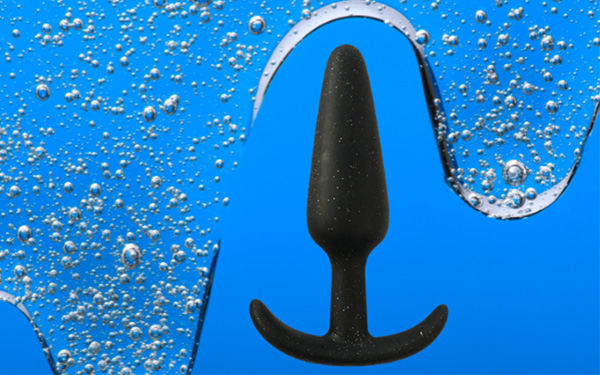Top 10 Anal Sex Rules

GoodVibes.com > How To Articles > Anal Sex
These top ten rules are adapted from anal sex rules written by Jack Morin, PhD, a San Francisco sex therapist and researcher and the author of Anal Pleasure and Health: A Guide for Men and Women.
1. Anal intercourse is the least frequently practiced form of anal sex.
There are many ways to enjoy the anus erotically. The most common techniques include touching the anal opening with a finger while masturbating or stimulating a partner’s anus during intercourse or oral sex.
Some people enjoy the sensation of a lubricated finger — their own or a lover’s — inserted into their anal opening and gently rotated. Others may prefer the insertion of a lubricated dildo or vibrator beyond the anal opening and short anal canal into the larger rectum. Many men, including heterosexuals, favor this form of penetration.
Oral-anal sex is popularly known as rimming. Some people enjoy performing it or allowing themselves to be probed in this special way. Using a dental dam is a way to ensure safe rimming.
2. Anal stimulation, including intercourse, is not painful if done properly.
The belief that anal stimulation, especially intercourse, has to hurt is a persistent and dangerous myth. Just as pain anywhere in the body indicates that something is wrong, so is the same true of the anal area. With its high concentrations of nerve endings, the anus can produce extreme agony when it is mistreated. Yet it can also be a source of great pleasure.
When a lubricated finger, object or penis is introduced into the anus, the anal muscles go into a spasm. Pain will result if the partners do not wait for these muscles to relax. Maximum anal pleasure requires the elimination of all pain or physical trauma from the anal experience. Self-protection on the part of the receptive partner involves being ready to say “no” until he or she is ready to proceed. Readiness is a combination of physical relaxation, usually helped along by plenty of leisurely anal touching, and desire.
3. Anal sex can be enjoyed even if it has been consistently uncomfortable in the past.
Sufficient desire alone does not necessarily guarantee pleasurable anal sex. Nor is an uncomfortable previous experience always the reason for a lack of interest in or desire for anal sex.
Chronic anal tension is the most common cause of anal discomfort during sex. Hemorrhoids and constipation are usually a sign of this condition. Tension can be relieved by touching the anus and becoming more familiar with it. An ideal time to explore the anal opening is while taking a shower or bath. Deep breathing also affects the anal muscles. Tensing the anus and then letting go is another way of learning to relax it.
Anyone who enjoys masturbation might want to experiment with some form of anal stimulation, though he or she should stop if any discomfort occurs.For many people the turning point in anal sex is when they allow a partner to massage the anus with the understanding that intercourse will not be attempted. Then the recipient of anal caresses can concentrate solely on the pleasure this erogenous zone is capable of generating.
4. Two muscle rings called sphincters surround the anal opening. Each functions independently.
If you insert a lubricated finger about one half-inch into your anus and press your fingertip against the side, you can clearly feel the two sphincter muscles. There is less than a quarterinch between them. The external sphincter is controlled by the central nervous system — just like the muscles of the hand, for example. You can readily tense and relax this sphincter whenever you want.
The internal sphincter is quite different. This muscle is controlled by the involuntary or autonomic part of the nervous system, which governs such functions as heartbeat and stress response.
The internal sphincter reflects and responds to fear and anxiety during anal sex. It will cause the anus to tense up automatically even if the receptive partner is trying to relax. Thus, precautions about safety and comfort are essential here.
Even if a person does feel comfortable during anal sex, he or she may still need to learn voluntary control over his or her internal sphincter in order to relax it at will. Doing so requires regularly inserting a finger, perhaps in the shower each day, and feeling the internal sphincter. The muscle changes spontaneously and in response to behavior. In this instance, simply paying attention is more important than trying to relax. Anyone can gradually learn to control the internal sphincter at will.
5. Anal stimulation provides many kinds of pleasure.
The highest concentration of nerve endings is around the anal opening itself. A finger can focus on them especially effectively. When an object or penis is inserted beyond the anal opening into the rectum, other pleasures are involved. The outer portion of the rectum, like the vagina, has several nerve endings. The inner portion responds mostly to pressure.
In men, the prostate — which is just beyond the rectal wall, a few inches in, toward the front of the body — can be a source of pleasure when massaged by a finger, an object, or a penis.
Also, the lower end of the penis, or “bulb,” is near the anal opening. It is stimulated indirectly by most types of anal sex.
Anal pleasure can be psychological as well as physical. The anal taboo adds to the thrill of the forbidden. The most common anti-anal message (it’s dirty!) sometimes returns as a source of raunchy, sleazy excitement. Rimming enthusiasts may enjoy the feeling that they are being disgustingly — and delightfully — perverse. Other people regard the anus as a secret, special place. Sharing it with a partner is an act of openness and giving.
6. Anal stimulation can lead to orgasm.
A minority of people can respond orgasmically to anal sex without direct genital stimulation. Orgasms from anal stimulation are most likely to occur when the participants become thoroughly absorbed in their sensations and fantasies. An almost certain way to prevent such an orgasm is to become determined to have one. Seeking an anal orgasm will create new pressures and disrupt the pleasure.
7. Diet contributes to the enjoyment of anal sex.
Regular bowel movements are the major function of the anus and the rectum. There must be sufficient fiber in a person’s diet to make his or her feces soft, bulky and well formed. This allows a bowel movement to be produced without force or effort. Forced evacuations irritate anal tissues, causing discomfort and adding to muscular tension. Fresh fruits, vegetables, whole grains or unprocessed bran are important sources of fiber.
8. Different rules of hygiene apply to the vagina and rectum.
Since intercourse can be vaginal or rectal, many people assume that the same rules apply for the penetration of the vagina and rectum. Although both are lined with soft tissue and are capable of expanding, they are radically dissimilar.
The rectum is not straight. After the short anal canal which connects the anal opening to the rectum, the rectum tilts toward the front of the body. A few inches in, it curves back -- sometimes as much as 90 degrees. Then, after a few more inches, it swoops toward the front of the body once again. A person can learn about the shape of his or her rectum by gently inserting a soft object, trying different angles and body positions and concentrating on how it feels. Make sure the object has a flared base so that if you lose your grip, it won’t slip into the rectum and become irretrievable.
The rectum does not produce lubrication like the vagina but only a small amount of mucus. Therefore, rectal penetration always requires a lubricant. Chemical additives should be avoided. Water-based lubricants are latex-compatible.
The main function of the rectum is to act as a passageway for feces. But feces are not normally stored in the rectum except just prior to a bowel movement. Yet small amounts may remain in the rectum, especially if the feces are not well formed. Anal douching before sex will help some people especially concerned with cleanliness to relax. For others the idea of dirtiness heightens the joy of the forbidden; for them, douching is anti-erotic.9. Anal intercourse is not necessarily a form of dominance and submission.
The top-bottom imagery associated with anal intercourse is wide-spread. No doubt the belief that anal sex has to hurt contributes to this notion. And in fact some people are intensely excited by top-bottom fantasies about anal sex. The thought that they are submitting to such a degrading act is a terrific thrill. However, actual, not fantasized, anal pain can lead to trouble.
For others, the enjoyment of anal sex is inhibited by top-bottom imagery. The idea of surendering control, and perhaps submitting to humiliation, causes immediate, protective tensing of the anal muscles. These individuals are more likely to relax and enjoy themselves if they can learn to regard anal sex as pleasurable rather than as an expression of power.
10. Anal sex can be perfectly safe, even beneficial.
The taboo against anal eroticism is perpetuated by the almost universal belief among physicians that anal sex is inevitably dangerous. No physical injury from anal stimulation results if both partners refuse to tolerate pain, use lubricant, never use force and avoid the use of drugs.
All the other risks center on sexually transmitted diseases. Each of the common STDs -- gonorrhea, syphilis, herpes -- can affect the anus. Intestinal parasites, bacteria or tiny bugs are usually passed along when fecal matter finds its way into someone’s mouth or vagina, most likely through rimming.
AIDS has complicated the matter. The HIV virus can pass from the semen or blood of an infected person to the bloodstream of a partner through a tiny break in the rectal tissue during anal intercourse.
To avoid this risk, anal intercourse and rimming should not be practiced unsafely. Those who do enjoy anal intercourse should always use a condom. Rimming should always be accompanied by a latex barrier. Of course, in a monogamous relationship with two healthy people, the risk of disease transmitted anally is reduced.
Thousands of men and women with chronic anal medical problems have restored their anal health by challenging their negative attitudes. This approach is indispensable for full erotic enjoyment of the anus.











